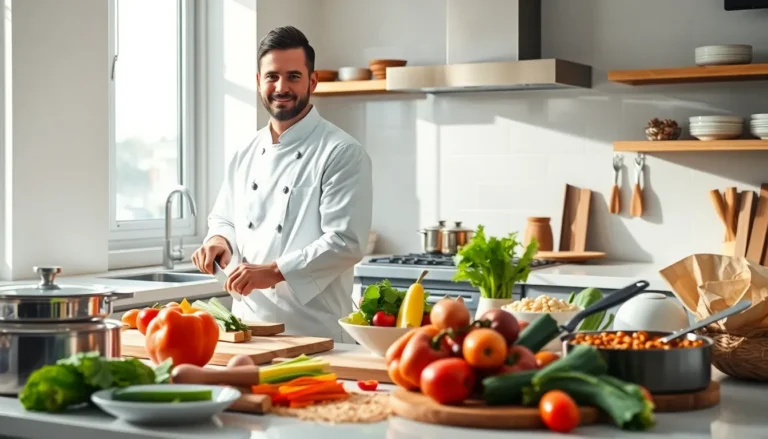Table of Contents
ToggleMoist cooking techniques are the culinary secret weapon that transforms ordinary meals into mouthwatering masterpieces. Imagine sinking your teeth into a tender, juicy piece of chicken or a perfectly cooked vegetable that practically dances on your palate. These techniques not only keep food moist but also elevate flavors, making every bite a delightful experience.
Overview of Moist Cooking Techniques
Moist cooking techniques incorporate water or steam, promoting tenderness and enhancing flavors in various foods. Methods such as boiling, steaming, and braising showcase this approach effectively.
Boiling involves immersing food in water, which allows for even cooking. Vegetables cooked this way retain nutrients, providing healthy options. It’s especially beneficial for pasta and grains, which absorb water during cooking.
Steaming, another efficient technique, preserves both texture and nutrients. Foods cooked via steaming often maintain vibrant colors and natural tastes. Use steamers or microwave-safe containers for convenient preparation.
Braising combines both moist and dry heat, starting with browning food before slow-cooking it in liquid. This method is ideal for tougher cuts of meat, transforming them into tender, succulent dishes. Flavors deepen as ingredients meld together, creating rich, satisfying meals.
Poaching is a gentle method involving cooking food in simmering water or broth. It preserves delicate items like fish, allowing for light and flavorful dishes. Seasoning the poaching liquid enhances the profile of the finished product.
Each technique offers unique advantages that contribute to superior meals. Chefs often utilize these methods to elevate the quality of their dishes, making them more appealing. Embracing moist cooking techniques results in improved texture and taste, leading to memorable dining experiences.
Benefits of Moist Cooking Techniques
Moist cooking techniques deliver substantial advantages, enhancing both the taste and quality of meals. These methods offer a variety of benefits that make cooking enjoyable and rewarding.
Improved Flavor and Tenderness
Improved flavor and tenderness often result from moist cooking methods. Braising, for example, allows flavors to meld, creating rich, savory dishes. Using moisture causes tougher cuts of meat to become incredibly tender, making them easier to chew. Steamed vegetables retain their natural flavors, often better than fried options. Poaching adds subtle flavor nuances without overwhelming delicate ingredients. Each technique encourages the natural juices of the foods to develop, resulting in satisfying and flavorful meals. Many chefs utilize these techniques to elevate their culinary creations, creating memorable dining experiences.
Nutrient Retention
Nutrient retention plays a key role in the benefits of moist cooking techniques. Steaming efficiently preserves essential vitamins and minerals, especially in vegetables. Boiling vegetables briefly maximizes their nutrient content, reducing nutrient loss compared to other methods. Poaching maintains the freshness of ingredients, allowing them to retain beneficial compounds. Braising helps tenderize while keeping nutrients intact, offering both flavor and health benefits. Each technique contributes to healthier meals, promoting well-balanced diets without sacrificing taste. Thus, these methods serve both wellness and culinary satisfaction effectively.
Common Moist Cooking Techniques
Moist cooking techniques are essential for enhancing the overall quality of dishes. These methods ensure flavorful and tender results, making meals more enjoyable.
Steaming
Steaming involves cooking food via steam, retaining nutrients and flavors effectively. Vegetables, fish, and dumplings benefit from this method, as it preserves their texture and natural colors. Steam penetrates food evenly, ensuring it cooks thoroughly without drying out. Cooking times vary based on the type of food; for instance, tender vegetables may require only a few minutes, while thicker cuts of meat need longer. As a result, steaming stands out as a healthy cooking option.
Poaching
Poaching consists of gently simmering food in liquid, such as water or broth, at low temperatures. Delicate items like eggs, fish, and fruits thrive in this environment, allowing flavors to meld subtly. Cooking temperatures typically range from 160°F to 180°F, ensuring that food cooks evenly without toughening. Chefs often add herbs or spices to the poaching liquid, enhancing the final dish’s flavor profile. Therefore, poaching is a versatile technique that emphasizes light and flavorful meals.
Braising
Braising combines both moist and dry heat, ideal for transforming tougher cuts of meat into tender, flavorful dishes. This technique involves searing food first and then cooking it slowly in a liquid, such as broth or wine. Cooking times vary, often exceeding two hours for larger cuts, allowing flavors to develop deeply. The process results in rich sauces, perfect for pairing with grains or vegetables. Braising not only enhances flavor but also tenderizes ingredients efficiently, making it a popular choice among chefs.
Tips for Perfecting Moist Cooking Techniques
Moist cooking techniques thrive on high-quality ingredients and precise temperature management. The following tips enhance cooking successes.
Choosing the Right Ingredients
Selecting ingredients greatly influences the outcome. Fresh vegetables retain better texture and nutrients during cooking, elevating dish quality. Using high-quality cuts of meat ensures tenderness after cooking methods like braising. For example, using chicken thighs provides a juicier, more flavorful result than chicken breasts. Opting for seasonal ingredients enhances flavor, as they often have optimal freshness and taste. Incorporating herbs and spices boosts overall complexity, enriching the final dish.
Temperature Control
Managing temperature ensures even cooking and prevents tough textures. Keeping the heat low during poaching maintains moisture and flavor, while high heat can lead to overcooking. For steaming, setting the right water level is crucial; too little water reduces steam efficiency. Using a food thermometer helps achieve ideal doneness, particularly for meats. Specific cooking times based on the food type must be followed for best results. Always remember that slow cooking enhances flavors, particularly in braising, allowing the meal to develop depth.
Moist cooking techniques offer a transformative approach to meal preparation. By utilizing methods like steaming, poaching, and braising, cooks can elevate the taste and texture of their dishes. These techniques not only enhance flavors but also promote healthier eating through better nutrient retention.
With the right ingredients and attention to detail, anyone can master these methods. The rewards are evident in the tender, juicy results that make every meal a delightful experience. Embracing moist cooking can lead to a deeper appreciation for the culinary arts and a commitment to creating exceptional dishes.



